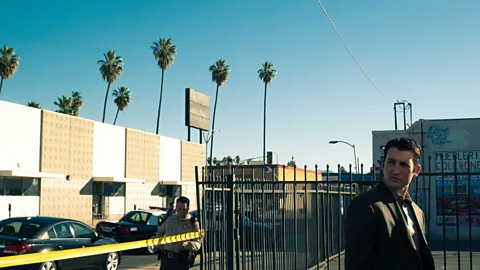Too Old to Die Young: ‘Evil at its most sordid’
 Amazon Studios
Amazon StudiosNicolas Winding Refn’s new TV series is full of the neon-lit violence and nudity for which the director has become known. It’s definitely not safe for work, writes Nicholas Barber.
Be warned: Ed Brubaker, the co-writer of Nicolas Winding Refn’s 10-part Amazon cop show, has called it “the most Nicolas Winding Refn thing that ever existed” – and he could be right. Beginning with the Pusher trilogy in Denmark and moving on to such English-language neo-noir provocations as Drive and Neon Demon, Refn has made films about one-eyed vikings and vampiric fashion models, but it’s become increasingly obvious what his obsessions are. He has even started replacing his name with a snappy brand – NWR – and what that brand signifies is taciturn anti-heroes, blood-splashing violence, neon-lit nocturnal cities, ominous synth scores by Cliff Martinez, and evil at its most sordid and merciless. Too Old to Die Young lets him luxuriate in those obsessions for 13 hours.
More like this:
In Refn’s US breakthrough, Drive, and its follow-up, Only God Forgives, the taciturn anti-hero was played by Ryan Gosling. But Gosling has since been busy starring in Damien Chazelle’s films, La La Land and First Man, so his place has been taken by Miles Teller, the star of Chazelle’s own breakthrough, Whiplash. In effect, Refn and Chazelle have swapped leading men. Still, Teller manages to be even more quiet and reserved than Gosling usually is. Playing a Los Angeles County sheriff called Martin, he has a cherubic pout, and a slight air of amusement, but he is almost as robotic as a Terminator with its batteries running down.
One reason why Martin is so withdrawn is that his partner has just been killed. He goes to a group, and he is in a relationship of sorts with Janey (Nell Tiger Free), the gifted teenage daughter of a billionaire tycoon (Billy Baldwin). But a gruff FBI agent-turned vigilante, Viggo (John Hawkes), offers another way for him to process the trauma. Gazing down from a hillside on to Los Angeles’ shimmering constellation of street lights, Viggo murmurs that “soon our cities will be washed away by floods, burnt to the ground”, and that the US will be engulfed by “a sea of barbarian hordes”. In this dystopian imminent future, someone will be needed to protect the innocent, a job that entails executing rapists with knives and golf clubs. Viggo currently does the job himself, with the help of a serene psychic (Jena Malone) who can divine people’s most disgusting secrets. But he is ready to on the mantle to Martin, who is fated, according to the psychic, to unleash “a new breed of destruction”.
So far, critics have only been shown episodes four and five of Too Old to Die Young, both of which premiered at the Cannes Film Festival. The fragmentary fourth episode introduces several key characters. The fifth episode works as a standalone film in which Martin, a kindred spirit to Joaquin Phoenix’s suicidal crusader in You Were Never Really Here, drives from LA to Albuquerque to deal with two sadistic brothers. Over all, the episodes mix David Lynch’s sinister surrealism with Michael Mann’s blue-sheened urban crime. Looking beyond cinema, you can spot the influence of Edward Hopper’s lonely nightscapes and Jim Morrison’s lyrical visions of an apocalyptic Los Angeles.
Maybe other episodes in the series will venture into new territory, and Refn will surprise us with a frothy musical comedy. But in the meantime, as Brubaker indicates, Too Old to Die Young is so representative of the director’s work that it could be a deliberate self-parody. The expressionless hero is sometimes indistinguishable from a waxwork dummy; the corruption and cruelty go past the human and into the realm of the demonic; the lighting is so trippy that you could be watching a science-fiction film; and the gratuitous nudity is as gratuitous as it gets, as if Refn were intent on annoying anyone who had ever accused him of misogyny and exploitation. NWR is definitely NSFW (not safe for work).
Another typically Refn-ish element is the slow pacing, which suggests that he had an idea for a 90-minute film and decided to let it play out over 13 hours. The dialogue scenes have hundreds of lines each, and every actor speaks those lines as if they had just ingested a week’s worth of prescription tranquilisers. In episode four, one character tells Martin that a plan is too complicated to explain. There is a long pause. “I’ve got time,” says Martin. There is another long pause. The first character replies: “I don’t. Life is short.” Without the pauses, they could have discussed every detail of the plan in the time it took them to intone those eight words.
On the other hand, some sequences jerk Too Old to Die Young into delirious life. In episode five, for example, Refn gives us the wild and witty car chase we were promised in Quentin Tarantino’s Death Proof, and indeed in Refn’s own Drive. One character is in a vintage muscle car, another is in a humming electric car, and the soundtrack that accompanies them from the city to the desert is Barry Manilow’s Mandy. Are these bravura sequences worth waiting for? Some viewers will be so frustrated by Refn’s self-indulgence that they will throw their remote controls at the wall: life is short, after all. But it is possible to be hypnotised by the woozy, psychedelic atmosphere and by the descent into nightmarish horror. The series is addictive, in an unpleasant sort of way. If Too Old to Die Young is this disturbing and uncompromising after five episodes, just imagine where it might go in the five that follow.
★★★☆☆
Love TV? BBC Culture’s TV Fans group on Facebook for more information and chat about your favourite shows.
